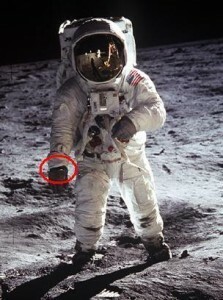One Giant Leap for Watchmakers
Sean Wilsey meets Buzz Aldrin
Buzz Aldrin may have been only the second man to walk on the moon, but he was the first to wear a watch on its surface. In 1962 Nasa visited a jewellery shop in Houston, bought some timepieces, and subjected them to what agency historians describe as ‘exhaustive tests aimed at determining performance reliability in the conditions likely to be experienced during EVA'. That acronym stands for ‘extravehicular activity’, which means moon walking, which means temperatures ranging from -250 to +250ºF. The agency also exposed the watches to ‘accelerations of 12gs’ and the violent shaking of a ‘vibration table’. The only one to survive was the Omega Speedmaster. Despite congressional pressure to buy American, Nasa went Swiss, and ordered one for every astronaut.
Neil Armstrong left his in the lunar module as a replacement for the ship’s timer (American-made), which had malfunctioned. Aldrin wore his strapped to the outside of his surface suit, because, as he said recently, he wanted it to do ‘more than just sit inside the spacecraft’. A few years later, back on earth, he lost it. But on a warm Wednesday evening in June, at an event to celebrate the 40th anniversary of the first moon landing, he could be found at the Omega store on Fifth Avenue, looking at replacements. (Aldrin, at ease in public, unlike the rest of his Apollo crew, is a regular on the promotional circuit, and was also featured in a recent Louis Vuitton campaign.)
White coated men with monocles hustled about. Aldrin, in a blue pinstripe suit, answered questions about time, Mars, and Magnificent Desolation, his recent memoir (the title a reference both to what the astronaut saw on the lunar surface and to his terrestrial struggles with alcoholism). During the Apollo programme, Aldrin and my aunt Glendora were neighbours. Thanks in part to Aunt Glen's enthusiasm, I had been reading his book. I told him I was enjoying it and had ‘just got to the point where you crash your Saab Sonnet’.
The astronaut responded with a jerk of the head and a disbelieving look. ‘That was a really bad time for me! Don’t talk about that!’
Then he reached down – onlookers could be forgiven for flinching, as Buzz had punched a man just a few years back for badgering him about complicity in the supposed faking of the lunar landing – fished around in his pocket, and pulled out an AA medallion, which he held up a bit too close to my face.
‘Twelve years,’ he said.
The medallion was gold and inlaid with red and blue stones. He repocketed it.
Nasa has spent the last few years designing and testing a new series of spacecraft to return to the moon and continue on to Mars. Aldrin, like many of his Apollo programme colleagues, is dismayed by the slowness of the project. The Obama administration recently convened a panel to review the whole thing and determined that there is not nearly enough money to make it happen. (Though there seemed to be more than enough in the Omega store.)
I asked Aldrin about the new lunar rover. A bystander and amateur lunar historian pointed out that Aldrin had never driven the original rover, and could not, therefore, be expected to have an opinion on the new one. There was a brief pause.
‘Beats walking,’ Aldrin said.
A woman with red red lips and white white hair walked past. She appeared to be a regular denizen of Fifth Avenue boutiques, and caught Aldrin's eye. After saying hello he asked: ‘Where do you live?’
‘New York,’ she replied. ‘But I see you in Monte Carlo all the time!’
He nodded.
‘See you there soon!’ she said.
The evening ended behind a pair of ebony pocket doors, where white-coated men and the Swiss president of Omega presented Aldrin with a diamond encrusted Speedmaster. The diamonds looked like – and looked valuable enough to get us to – the stars.
